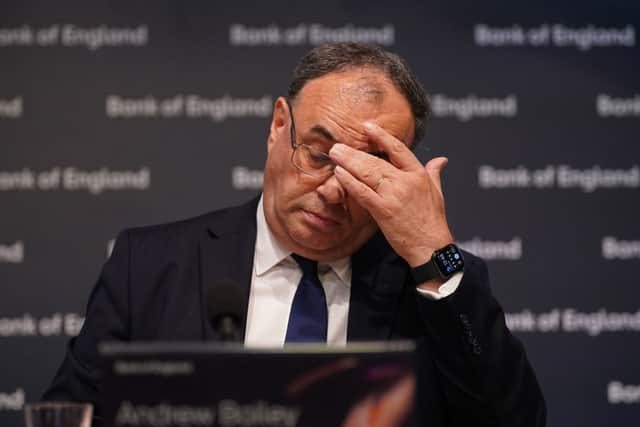What is stagflation? Meaning of economic term, what it means for UK economy, how it can be stopped - explained
and live on Freeview channel 276
The UK economy is on course for a tough 12 months, after the Bank of England hiked interest rates to 1.75% and forecast a year-long recession from the end of 2022.
It comes as the UK is already battling a major cost of living crisis spawned by record inflation - a crisis that looks set to get worse as the UK central bank predicted average price rises could increase to 13% in October as a result of rocketing energy bills.
Advertisement
Hide AdAdvertisement
Hide AdThe dual economic pressures of a recession and high inflation have led to fears the UK could be on course for a period of ‘stagflation’ - something the country has not faced since the 1970s.
But what exactly does this term mean, why is it bad - and how can it be resolved?


What is stagflation?
Stagflation is an economics term used to describe a period of high inflation, relatively high unemployment and low demand for products.
These don’t necessarily happen in that order.
Stagflation was a major issue for the UK in the 1970s, but think tank the National Institute of Economic and Social Research (NIESR) has warned it could be on its way again.
Advertisement
Hide AdAdvertisement
Hide AdIn its latest UK Economic Outlook report, it predicted GDP growth will slow from 3.5% in 2022 and 0.5% in 2023, while unemployment will rise above 5% - it’s currently 3.8%.
It also predicted further increases in inflation and a real-terms drop in consumer spending power of 2.5%.
Currently, the UK is already seeing high inflation - 9.4% as of June 2022 - while the Bank of England has predicted a recession is on its way from the final quarter of 2022.


What causes stagflation?
A sudden shock in the supply of goods can result in a rapid increase in prices.
Advertisement
Hide AdAdvertisement
Hide AdThis has been seen since the energy crisis began in autumn 2021 when a shortage of gas led to wholesale prices skyrocketing and many UK suppliers struggling to meet costs.
Unable to pass the expense on to customers due to the energy price cap, some providers went bust.
There are other examples elsewhere, too, with the slowdown more acute in manufacturing, where production has only risen modestly over the past 12 months due to severe supply-chain disruption and softening demand.
Employment growth in manufacturing has also slowed as a result of fewer orders and low availability of workers.


Why is stagflation bad?
Advertisement
Hide AdAdvertisement
Hide AdStagflation is a period when there is a disruption to demand for products, high inflation and higher unemployment.
Ultimately - if the economy retracts, demand drops and more people become unemployed - the private sector becomes less willing or unable to invest in the UK economy, and the government cannot generate as much money through taxation.
Less income for the public purse means public spending could be forced down - something which could see cuts to public services and public sector wages, as well as a lack of fiscal headroom to provide more cost of living support.
It leaves the UK’s next Prime Minister - either Liz Truss or Rishi Sunak - facing difficult decisions about how to get the economy back on track.
Advertisement
Hide AdAdvertisement
Hide AdFor example, high inflation and low demand have seen the Purchasing Managers’ Index (PMI) - a yardstick for manufacturing confidence - fall to a 25-month low of 52.1 in July 2022.
“Rising market uncertainty, the cost of living crisis, war in Ukraine, ongoing supply issues and inflationary pressures are all hitting demand for goods at the same time, while lingering post-Brexit issues and the darkening global economic backdrop are hampering exports,” said Rob Dobson, director at S&P Global Market Intelligence - a financial analytics firm.
"With the Bank of England implementing further interest rate hikes to combat inflation, the outlook is beset with downside risks. With this in mind, the continued low degree of optimism among manufacturers is of little surprise.”
However, Mr Dobson added that there was a silver lining as inflation and supply chain disruption appears to have peaked.
How can stagflation be resolved?
Advertisement
Hide AdAdvertisement
Hide AdOnce stagflation happens it can be difficult to stop, with policymakers needing to lower inflation and unemployment at the same time.
It is thought that lowering inflation in the long term typically increases unemployment in the short term. Likewise, lowering unemployment in the short term increases inflation in the long term.
In its report, NIESR urged the government to combat the issue by introducing more targeted support for vulnerable households, increasing public sector wages and reducing trade barriers with the UK’s biggest trading partner - the EU.
On the latter front, it warned against provoking a trade war with the EU over the Northern Ireland protocol.
Comment Guidelines
National World encourages reader discussion on our stories. User feedback, insights and back-and-forth exchanges add a rich layer of context to reporting. Please review our Community Guidelines before commenting.
